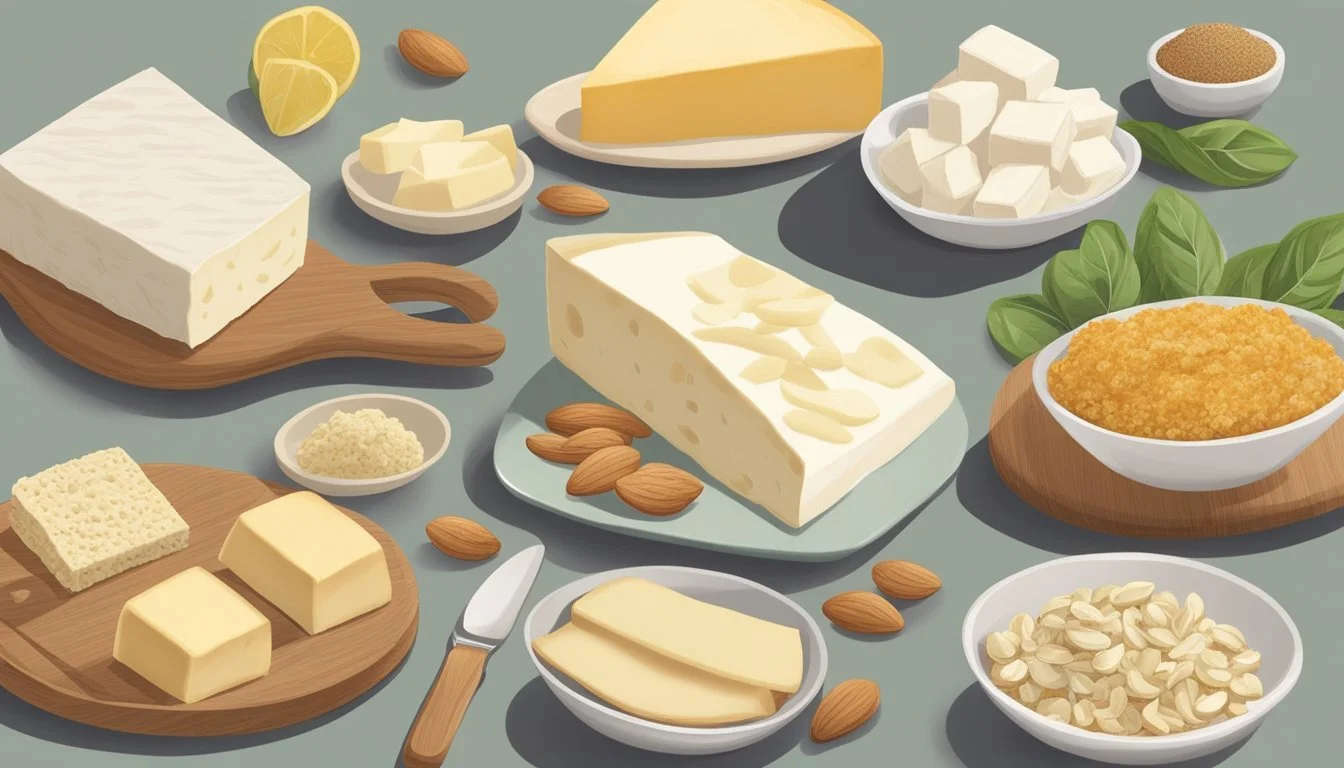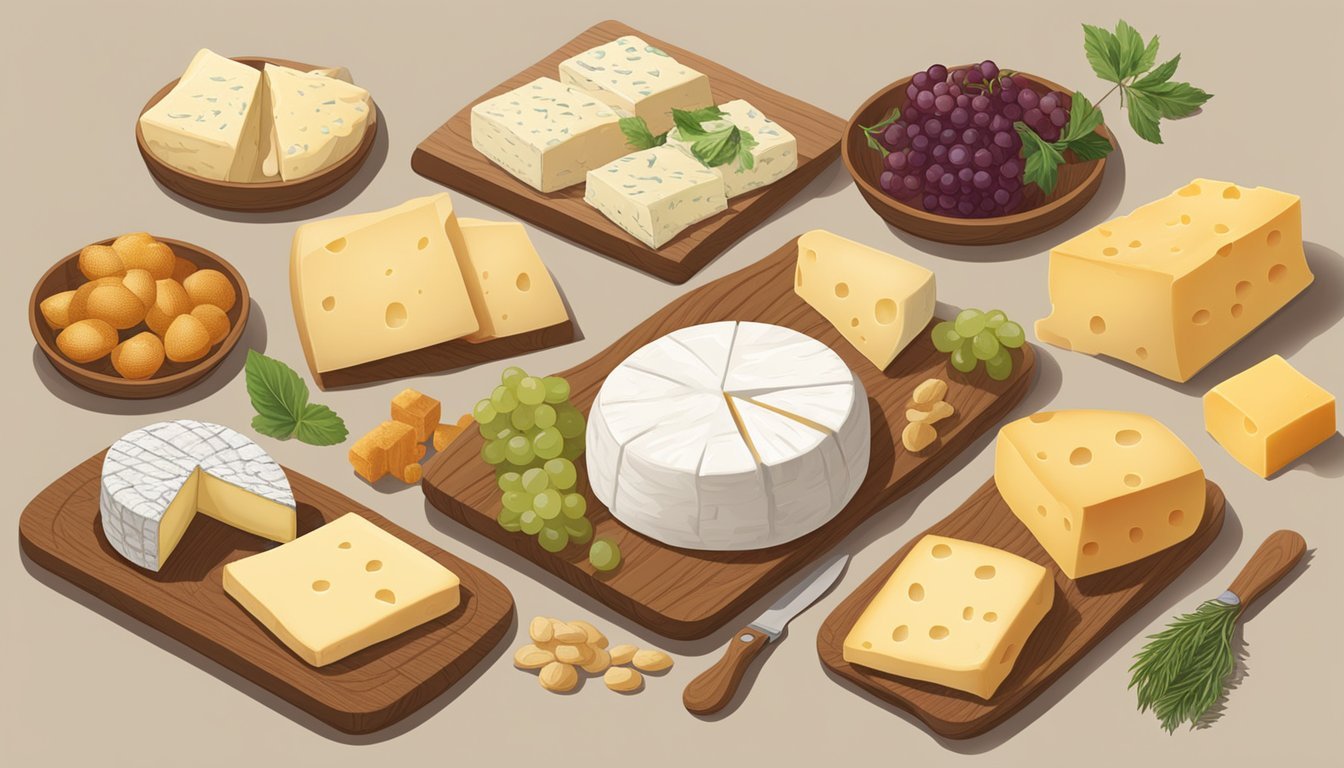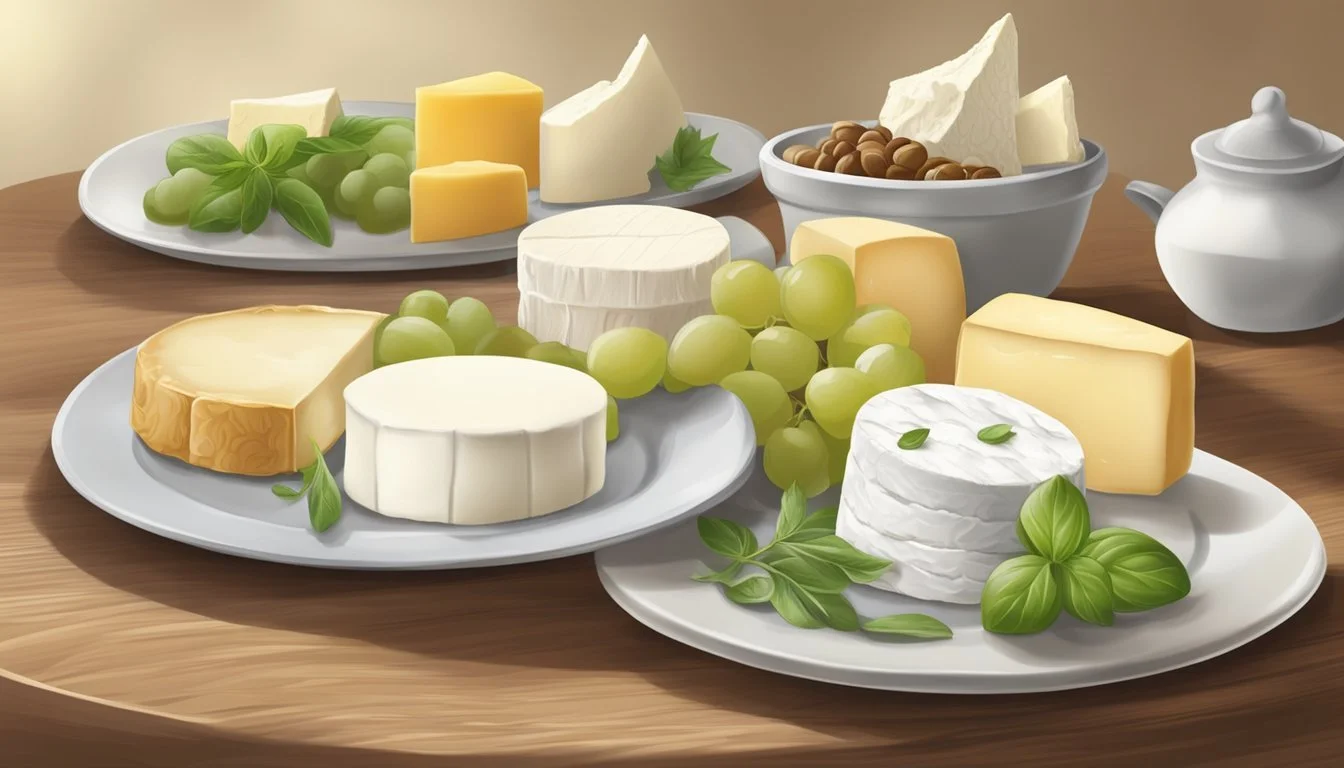Brie Cheese Substitutes
Top Alternatives for Your Cheese Board
Brie cheese (What wine goes well with cheese?), originally from France, is renowned for its creamy texture and earthy, nutty flavor that captivates the taste buds of cheese aficionados worldwide. It holds a prestigious position among soft cheeses, characterized by its white rind and rich, buttery interior. Despite its popularity, there are instances where one might seek an alternative, whether due to availability, dietary preference, or simply to explore different flavors in culinary applications.
Several cheeses share similarities with brie in terms of texture and taste, making them suitable substitutes. From the creamy paglietta with its shared nutty and fruity tones to the smooth and elastic fontina, which offers excellent melting qualities, options abound. Goat cheese, or chevre, with its distinctive tang, serves as a great alternative, especially when used in hot dishes such as paninis or casseroles where brie's subtle flavor might be overshadowed.
Taleggio cheese, another Italian variety, can be employed as a brie substitute for those desiring a slightly stronger flavor. Its washed-rind imparts a distinguishing aroma and when ripe, it acquires a pudding-like consistency that proves as versatile as brie. Gouda, with its slightly nutty and buttery flavor profile, is also among the preferred choices. This Dutch cheese, particularly when young and creamy, emulates the texture of brie and can complement an array of ingredients just as well.
Understanding Brie Cheese
Brie cheese, known for its creamy texture and mild flavor, is a staple in cheese assortments across the globe. This section explores the characteristics that define Brie, its production and the different types available, as well as guidance on how best to serve and pair this distinguished soft cheese.
Characteristics of Brie
Brie, originating from France, is a soft cheese noted for its rich, creamy interior and edible white rind. This cheese often presents a pale golden interior which is encased by a rind that's typically white due to a mold known as Penicillium camemberti. The texture of Brie is sumptuously creamy, especially when allowed to reach room temperature, enhancing its buttery consistency. Taste-wise, Brie offers a mild yet distinctive flavor, often described as earthy with nutty undertones and a hint of fruitiness.
Production and Types
Brie is traditionally made using unpasteurized cow's milk, although many versions available outside France use pasteurized milk due to food safety regulations. The cheese is classified into two main categories: Brie de Meaux and Brie de Melun, each named after the town in France where they originated. Additionally, there are varieties such as triple cream Brie which incorporate extra cream into the milk to create a richer, more decadent cheese. The production process involves curdling the milk with enzymes and culture, then later, the curds are cut, molded, salted, and left to age for several weeks.
Serving and Pairing
Brie cheese is highly versatile and can be enjoyed in numerous ways. It is often included in sandwiches or served with crackers and fruits as part of a cheese platter. Brie pairs beautifully with a variety of wines, from light reds like a young Pinot Noir to fruity whites like a Chardonnay. The flavors of Brie also complement lagers and fruit beers. The ideal serving condition for Brie is at room temperature, as chilling tends to suppress its delicate flavors and firm up its texture, while warmth accentuates the creaminess.
Dairy-Based Brie Substitutes
When seeking a Brie substitute, one may look for cheeses with a similar creaminess or flavor profile. Options range from closely related cheese varieties to common cheeses found in many kitchens.
Similar Cheese Varieties
Certain cheeses closely resemble Brie in both taste and texture:
Coulommiers: Often regarded as Brie's close cousin, Coulommiers is a bit denser but shares a similar creamy, buttery flavor.
Camembert Cheese: This Normandy cheese, with its similar earthy, rich taste and creamy texture, is a perfect swap.
Fontina: A gentle semi-soft cheese from Italy, with a slightly tangy edge, making it a good melting substitute.
Fromage d’Affinois: This cheese sports a similar richness to Brie, with a creamy and smooth consistency.
Taleggio Cheese: Its mouthfeel is quite brie-like, featuring a fruity tang.
Exquisite Alternatives
For those looking to elevate their dish with a unique twist:
Reblochon: A washed-rind cheese from France, Reblochon introduces a nutty note to dishes.
Explorateur: A triple-cream cheese that offers a luxuriously rich flavor and texture.
Saint-André: With a buttery and rich profile, Saint-André can act as a more decadent stand-in.
Common Kitchen Cheese Substitutes
More accessible cheeses that can replace Brie in a pinch include:
Goat Cheese (Chevre): Its creamy texture and a slight tang can mimic Brie’s attributes well.
Mozzarella Cheese: While milder, it melts beautifully and can work in heated dishes.
Gouda Cheese: A semi-hard cheese that, when young, offers a mild, slightly sweet taste similar to Brie.
Non-Dairy and Vegan Alternatives
For individuals seeking brie cheese substitutes due to dietary restrictions or ethical choices, a world of non-dairy and vegan alternatives awaits. These options replicate the creamy texture and rich taste that brie lovers appreciate.
Plant-Based Cheese Substitutes
Vegan Brie: Vegan brie options are often based on nuts like cashews or almonds, perfectly mimicking the creamy consistency of traditional brie. The fermentation process used in vegan brie yields the subtle tang that is characteristic of dairy-based brie.
Ingredients Commonly Used:
Cashews or almonds
Coconut oil for richness
Nutritional yeast for a cheesy flavor
Agar-agar for firmness
Store-Bought Brands: Many brands specialize in vegan cheeses with a variety that includes brie-style spreads and blocks. Consumers can look for these alternatives in health food stores or larger supermarkets.
Unconventional Brie Substitutes
Fresh Goat's Cheese: While not plant-based, goat's cheese can serve as a brie substitute for those who avoid cow's milk. It has a tangy flavor and comes in a similar soft texture but is not vegan.
Suitable For:
Individuals who avoid cow's milk but not dairy altogether
Those looking for a tangier taste
Camembert-Style Cheeses: Some non-dairy camembert alternatives use the same base ingredients as vegan brie and are designed to provide a similar experience to their dairy counterparts.
Notable Characteristics:
Mold-ripened rind similar to traditional camembert
A creamy inside that mimics the softness of brie
While the selection of non-dairy and vegan brie alternatives continues to grow, these products can vary in taste and texture. Consumers may need to try different brands and recipes to find their preferred substitute.
Brie Substitutes in Recipes
Selecting a substitute for Brie cheese in recipes largely depends on the dish's cooking method and the desired texture and flavor profile. Here are several alternatives to consider when Brie is not an option.
Baked and Cooked Dishes
For dishes that are baked or cooked, such as casseroles or cheese fondues, Camembert offers a similar creamy texture and rich flavor. It melts smoothly, making it a suitable choice for a similar result to Brie. Fontina, with its ability to melt effortlessly, can also be used for a distinct nutty flavor and slightly elastic consistency. These cheeses ensure the dish retains the intended luscious mouthfeel.
Sandwiches and Wraps
When preparing sandwiches or wraps, Gouda can be a smart choice for its creamy texture and mild yet slightly nutty taste. Gouda works well in a panini or toasted sandwiches where the melted cheese is a focal point. Chèvre (goat cheese) is another versatile option. It's tangy and can stand up to bold flavors in wraps, whereas Mozzarella is a more neutral, safe choice for a gentle cheesiness without overpowering other ingredients.
Appetizers and Cheeseboards
On a cheeseboard or in appetizers, Triple Cream Cheese is a decadent alternative that delivers a supremely creamy experience similar to Brie's luxuriant richness. Taleggio, with its tangy profile and soft texture, can add character to any appetizer spread. For those who enjoy a mild but flavorful cheese, Port Salut with its velvety taste can replace Brie cheese effectively on a cheese platter, pairing delightfully with fruits and crackers.
Selecting the Right Substitute
When one is looking for a Brie cheese substitute, it is essential to consider how closely they want to mimic Brie's distinct flavor and texture. The substitutes should complement the original cheese's taste profile and consistency to deliver a comparable experience.
Flavor Profiles
Brie cheese's flavor is often described as rich, buttery, and somewhat earthy, with a mild and delicate finish. When selecting a substitute based on flavor, it is useful to compare the cheese's characteristics with those of potential replacements:
Creaminess: Triple cream cheese offers an extra buttery and creamy taste, making it an exceptional Brie replacement.
Mild Taste: For a milder flavor, Camembert can be a good choice, providing similar subtle, buttery notes.
Pungent Options: A more robust option like Taleggio can provide a pungent kick while maintaining a creamy texture.
Earthy Undertones: Cheeses like Port Salut carry earthy notes that can come close to the depth found in Brie.
Texture Compatibility
Brie is celebrated for its soft, creamy interior and its white, edible rind. An ideal substitute should closely match this textural character:
Softness & Spreadability: For example, Chevre or goat cheese, while offering a distinct flavor, can replicate the soft and spreadable nature of Brie.
Melting Qualities: When melted, Brie becomes exceptionally smooth and creamy. Fontina, being slightly elastic but still smooth when melted, can be a suitable stand-in for cooking applications requiring melted cheese.
Comparable Rinds: Some Brie substitutes, like Fromager d'Affinois, also have a white rind, contributing to the textural similarity.
Identifying the right Brie substitute depends on one's specific needs, whether maintaining the original's creamy consistency, mirroring its nuanced flavor, or achieving a balance of both.
Health and Nutrition Considerations
When considering substitutes for Brie cheese, one must take into account the fat content and calories, potential lactose and allergy concerns, and the implications of choosing cheeses made from raw milk.
Fat Content and Calories
Brie cheese is known for its creamy texture, which comes from its high fat content. When searching for substitutes, it's important to compare the nutritional profiles. Soft cheeses like Camembert and Fromager d'Affinois tend to have similar fat levels; however, hard cheeses may offer a slightly lower fat and calorie option.
Brie Cheese (per 100g): Approximately 27g fat and 334 calories
Camembert (per 100g): Roughly 24g fat and 300 calories
Fromager d'Affinois (per 100g): Similar to Brie
Lactose and Allergies
Cheese contains lactose, a natural sugar found in milk products. While aging can reduce lactose content, those with sensitivities should still be cautious. Goat cheese (Chèvre) provides an alternative that some find easier to digest due to its different protein structure compared to cow's milk cheeses.
Brie Cheese: May contain residual lactose
Chèvre: Often more tolerable for those with mild lactose sensitivities
Raw Milk Cheese Concerns
Brie and many of its substitutes can be made from pasteurized or unpasteurized (raw) milk. It is important to note that cheeses made from raw milk can carry bacteria which may be harmful for certain individuals, such as pregnant women, young children, the elderly, and those with compromised immune systems.
Pasteurized Cheese: Generally considered safe for all populations
Raw Milk Cheese: Should be consumed with caution due to potential bacteria
Cultural and Regional Preferences
In choosing Brie cheese substitutes, one should consider the regional cheese-making traditions and the cultural context of the varieties available. This distinction influences both the choice and the flavor profile of the cheese.
French Cheese Alternatives
In France, there is a rich tradition of producing soft cheeses that can serve as alternatives to Brie. Coulommiers cheese is similar to Brie but thicker, offering a dense, creamy characteristic. Camembert cheese, often confused with Brie, has a more pronounced flavor and firmer texture, while Explorateur cheese provides a richer, more buttery experience. For those who enjoy a more textured feel, Reblochon cheese presents a nutty taste and a smooth, velvety finish. Saint André, a triple crème cheese, delivers an indulgent richness.
Cantal Jeune: A firmer option with a mild, buttery flavor, aged for a shorter period.
Saint-Nectaire: Exhibits a creamy and slightly nutty profile, reminiscent of the countryside.
Port Salut: Mild and smooth, this semi-soft cheese is known for its appealing orange rind and savory taste.
Cheese Varieties Worldwide
Beyond France, many regions produce cheeses that can stand in for Brie while introducing new flavors. Italy offers Paglietta, a creamy cheese with a robust taste, and Toma cheese, which provides a more rustic, country-style option. Both showcase the Italian preference for pronounced yet balanced flavors.
Chevre Cheese: A staple in many cuisines, this goat's cheese variant adds a tangy twist to the creamy texture.
Saint-Nectaire: Positioned as an international favorite, this cheese brings a subtle nutty and fruity flavor to various dishes, often used as a Brie substitute outside of France.
Each country's cheese reflects its cultural and environmental influences, thus impacting the selection available for those seeking alternatives to Brie.
Preservation and Storage of Cheese Substitutes
When cheese lovers seek alternatives to Brie, the preservation and storage of these substitutes play a crucial role in maintaining their delicate flavors and textures. Cheese substitutes vary in firmness and pungency, requiring specific conditions to preserve their qualities.
Refrigeration is essential for most soft cheeses. Substitutes such as Camembert, Coulommiers, and Port Salut should be kept at a steady temperature ranging from 35-45°F (2-7°C). This cool environment helps in slowing down the growth of bacteria and preserving the cheese's intended taste and smell.
For proper storage, one should:
Maintain original packaging: If possible, keep the cheese in its original packaging. This packaging is usually designed to protect the cheese's flavor and texture.
Use wax paper or cheese paper: If the original packaging isn't accessible, wrap the cheese lightly in wax paper or cheese paper. This allows the cheese to breathe without becoming too dry.
Avoid airtight containers: Soft cheeses require some airflow. Airtight containers can lead to unwanted moisture and condensation, which might spoil the cheese.
When handling more pungent cheese substitutes like Taleggio, it's important to store them separately to prevent their strong aromas from affecting other foods in the refrigerator.
Finally, some cheese varieties, such as certain types of goat cheese, can differ in storage needs. Always consult the specific storage instructions for each cheese type. Proper adherence to these guidelines ensures that the nuanced flavors and desired textures of Brie substitutes are retained for optimal enjoyment.
Conclusion
Choosing a substitute for Brie cheese depends on one's specific needs and taste preferences. For those who appreciate a similar creamy texture with mild flavors, Camembert and Fromager d'Affinois are excellent alternatives that offer comparable richness.
Chevre (Goat Cheese), with its distinct taste, provides a tangier option. It's suitable for individuals looking for a robust flavor profile. Gouda, noted for its smoothness and slightly nutty taste, is another solid choice, particularly when a milder variant is preferred.
For vegans or those with dairy allergies, plant-based cheeses have come a long way and can offer a similar mouthfeel and versatility in dishes.
Table: Selected Brie Cheese Alternatives and Their Characteristics
Alternative Texture Flavor Notes Best Uses Camembert Creamy Rich, buttery Cheeseboards, Baked Fromager d'Affinois Soft Mild, creamy Sandwiches, Spreads Chevre (Goat Cheese) Dense Tangy Salads, Tarts Gouda Semi-hard Nutty, buttery Melting, Snacking
The culinary world thrives on exploration, and discovering the right Brie cheese substitute can lead to new and exciting taste experiences. One's choice should be informed by an authoritative understanding of the flavors and textures of potential alternatives. This comprehensive information enables informed decisions that enhance any culinary creation.









